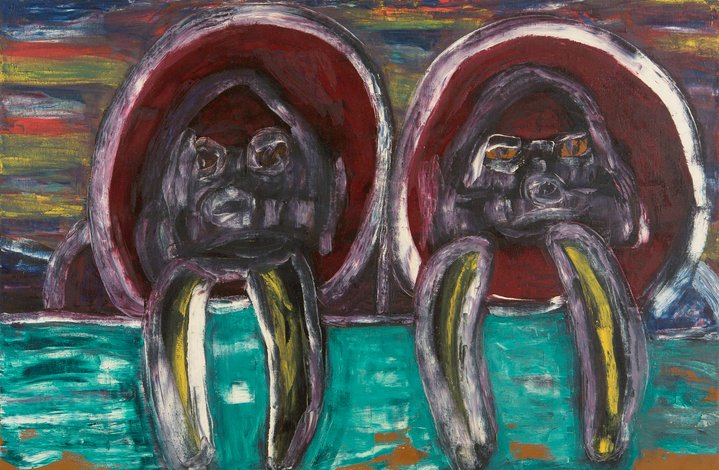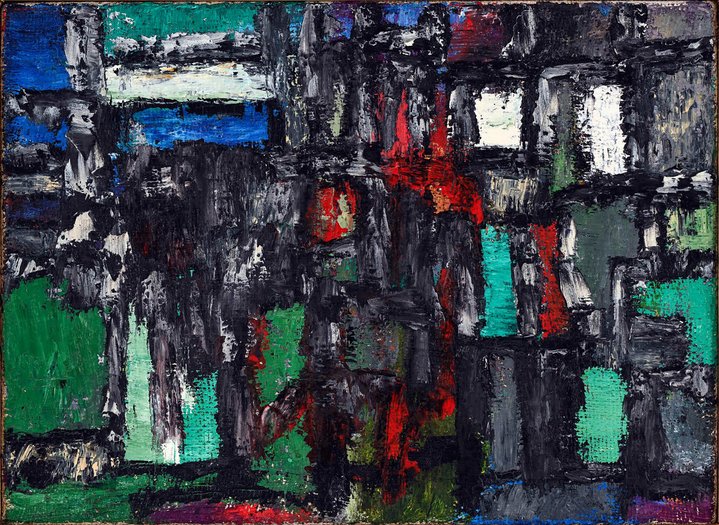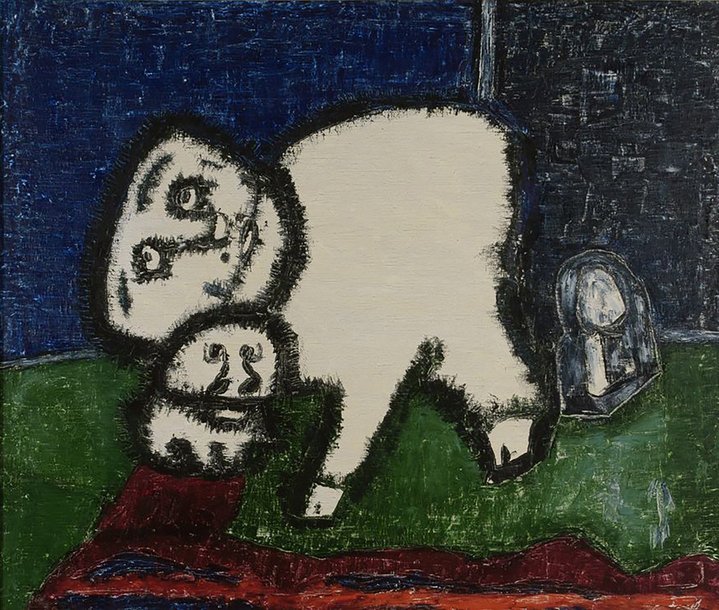Bob Koshelokhov: The Titan from St. Petersburg

Bob Koshelokhov. Untitled. Oil on canvas. Courtesy of Artstory Gallery
Moscow’s Artstory gallery is unveiling a retrospective exhibition of the late underground artist Boris (Bob) Koshelokhov. St. Petersburg art critic and curator Dimitri Pilikin describes his encounters with this legendary and eccentric character.
Everyone called him the ‘Titan’ — there was a sign with this word outside the house where Bob Koshelokhov (1942–2021) lived for twenty years — and his fate was like the script of a Hollywood blockbuster. He was an orphan from the Southern Ural city of Zlatoust, who had come to Leningrad to study medicine, was named there as an artist in the dark 1970s, married an Italian woman and made his escape behind the Iron Curtain, but who just as quickly returned from the ‘golden cage’ to the familiar life of an anachorite - a hermit, philosopher and guru.
The deadly chimera managed to get its hands on even the immortal and the legendary. Boris (Bob) Koshelokhov died last year at the age of 79. He was an undisputed hero of the Leningrad underground of the seventies. There is a page from his handwritten autobiography in a museum archive: "In 1977, I had an idea to create a group of artists, which I decided to call Letopis (‘The Chronicle’). An artist is also a chronicler, but unlike a historian, an artist must be ruthless in his/her choice of material. With an artist it’s not about taking a cross-section from a microscopic grain. With an artist, a slice of being is taken out of the heart. At that time, I already knew quite a few artists who were not engaged in social realism, and I sensed that there were other directions in art. Leonid Fedorov, Alexander Vassiliev, Kira Stepanova, Rita Utekhina, Nelly Poletaeva, Lena Figurina, Timur Novikov and Misha Goroshko were there beside me. We quickly defined what we needed to do. We would meet once a week, but always with new works, and we discussed these works and searched for a new pictorial language. Anyone who did not bring a new work would not be allowed to take part in the discussion. I put forward three mottos: “We paint our soul in anything and everything”, “Everybody is an artist”, “Work, work and work” (Koshelokhov, of course, used a more brutal verb not to be used in print).
In 1978, Bob unexpectedly married an Italian aristocrat, rolled up his paintings and left for Italy. This fantastic twist of fate itself is deserving of a separate story. The activities of the Letopis group folded at this point, but some members, such as Timur Novikov (1958–2002) and Elena Figurina (b. 1955), became stars in their own right. Returning again to his autobiography, Koshelokhov describes his tour abroad rather sparingly: “In Italy, I had several solo exhibitions. In addition, I took part in the Venice Biennale. I left the Soviet Union because I didn't want to live in an iron cage, but I ended up in a golden cage in Italy. The food, clothes, accommodation and working conditions were luxurious. But it seemed to me that an iron cage was better than a golden one and I preferred to return”.
At the end of the 1970s, Koshelokhov moved into a communal flat on the corner of Nevsky Prospekt and Vladimirsky Prospekt, opposite the cult cafe, popularly nicknamed ‘Saigon’. It was a long, elongated hall with standing marble tables and Hungarian coffee machines. It was there, in the 1970s, that you could easily meet with all the heroes of the Leningrad underground: musicians, poets, writers, thespians, theatre directors and artists ranging from Boris Grebenshchikov (b. 1953) and Sergei Kuryokhin (1954–1996) to Viktor Krivulin (1944–2001) and Arkady Dragomoshchenko (1946–2012). Poet Dragomoshchenko, incidentally, also left a vivid memoir of a visit to Koshelokhov's communal apartment: “It was there, on the top floor, that I once visited him with the fantastically beautiful Josephine Guatarra and her friend, Sean Kelly, editor of Flash Art, a magazine at that time not yet translated into Russian. They were gorgeous in cheeky Parisian attire and make-up, overturning any assumptions about American university life. When asked ‘How do you work?’, Boris Koshelokhov shrugged his shoulders and did not understand. In fact, Kelly's question was, ‘What do you need to work? Vodka? Hashish? Coffee?’. After thinking it over, Koshelokhov replied:’I don't need anything. I need to find a space in front of the canvas and go to sleep. When I work I need to sleep properly. What is amazing is that I wake up when the work is really finished’.
He lived in a tiny 16 square metre studio for almost 20 years. It was filled with his paintings and he was always painting new ones, two or even three a day. In the middle of the day, he'd go out to Saigon, have a strong coffee, smoke a cigarette, chat with friends and go back to work on the next painting. When there was no canvas, he used curtains, tablecloths or even tarpaulins. He bought paint in cans and painted with impasto, in thick coats, using a broad brush or directly with a palette knife. At that time he had not yet arrived at his fundamental cycles, but painted single canvases. The number of paintings he made ran into the hundreds. Close friends recall that he had a special ritual. When he painted another hundred paintings he would shave his beard, shave his head and go to the Russian sauna. In between, he would grow back his hair and beard. He worked and went out in the street always wearing the same clothes without any social niceties. However, it was obvious to everyone that they had met a genius and an extraordinary man who was completely immersed in art and did not think about the conventions of everyday life. And he was only talking about philosophy, art and literature because he read a lot. His eyes were always wide open and he looked like a blissful fanatic or a hermit. And so he was.
At the beginning of the 1980s, like many heroes of the Leningrad underground generation of janitors and watchmen he got a job as a stoker and used the boiler-room and some tree trunks he had found to make wooden sculptures. His sculptures, too, were rather wild and more like idols or totem poles.
In the late 1980s, a new life began. The first art squats appeared, and they were close in spirit to the underground character of our hero. He managed to work in the legendary "NCh/VCh" squat on Kalyaev Street, and in 1989 he got a studio at Pushkinskaya 10. I remember going to Pushkinskaya 10 one day and finding that he had not knocked down a single wall in the dilapidated communal flat he had been given. But all the walls had two metre long canvases nailed directly onto them. Moreover, the distance from wall to wall was literally a metre and a half and it was a total mystery as to how he had painted them. I was surprised and asked. But he smiled and said: “It's going to be OK”. And indeed, when these canvases were displayed and mounted in the vast space of the Manege exhibition hall at his solo exhibition, every line and every spot of colour matched organically. That was what he was - a Titan.
Bob Koshelokhov. Extreme Expressionism
Moscow, Russia
June 30 – July 31, September 6 – October 2, 2022









